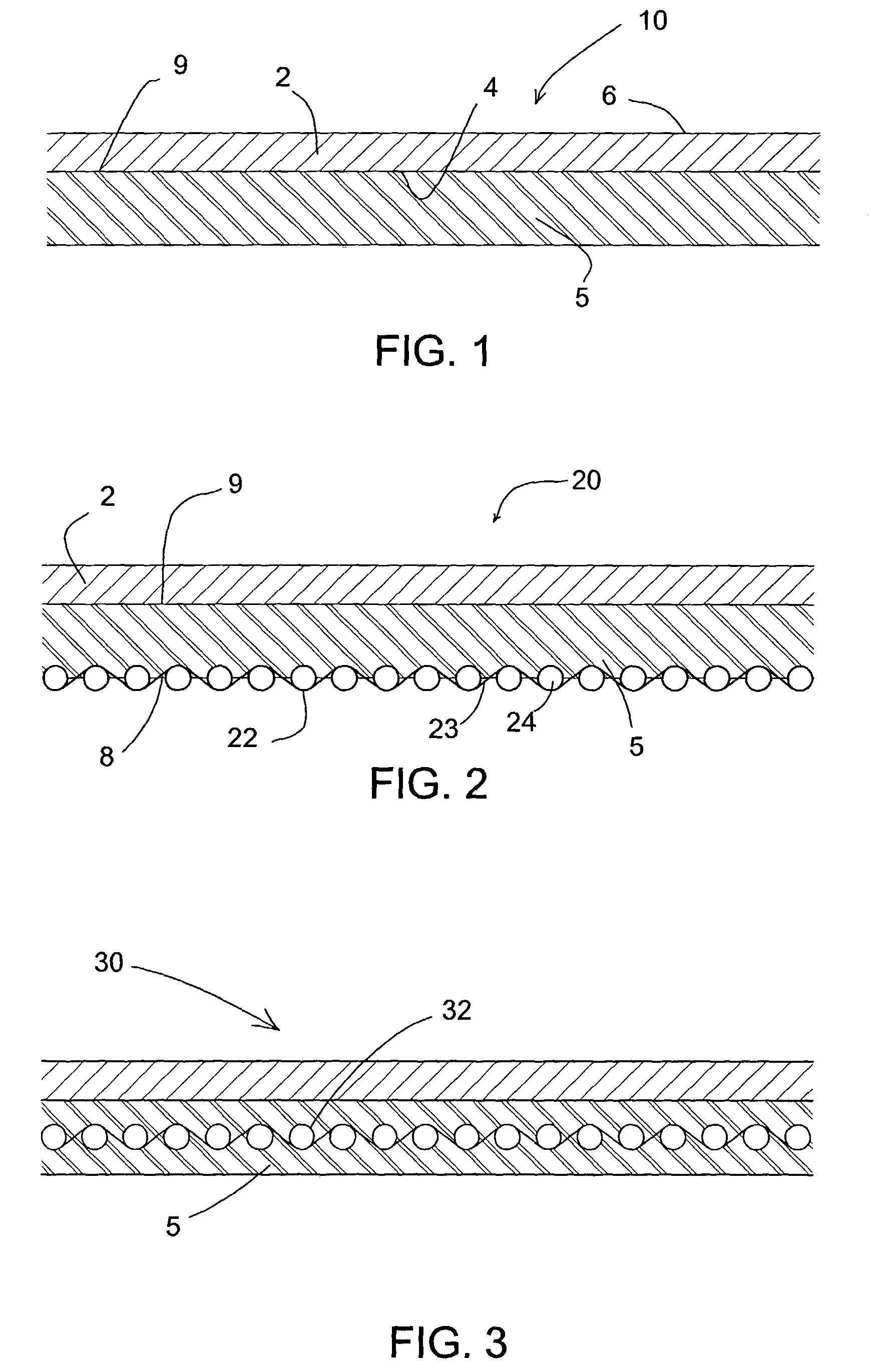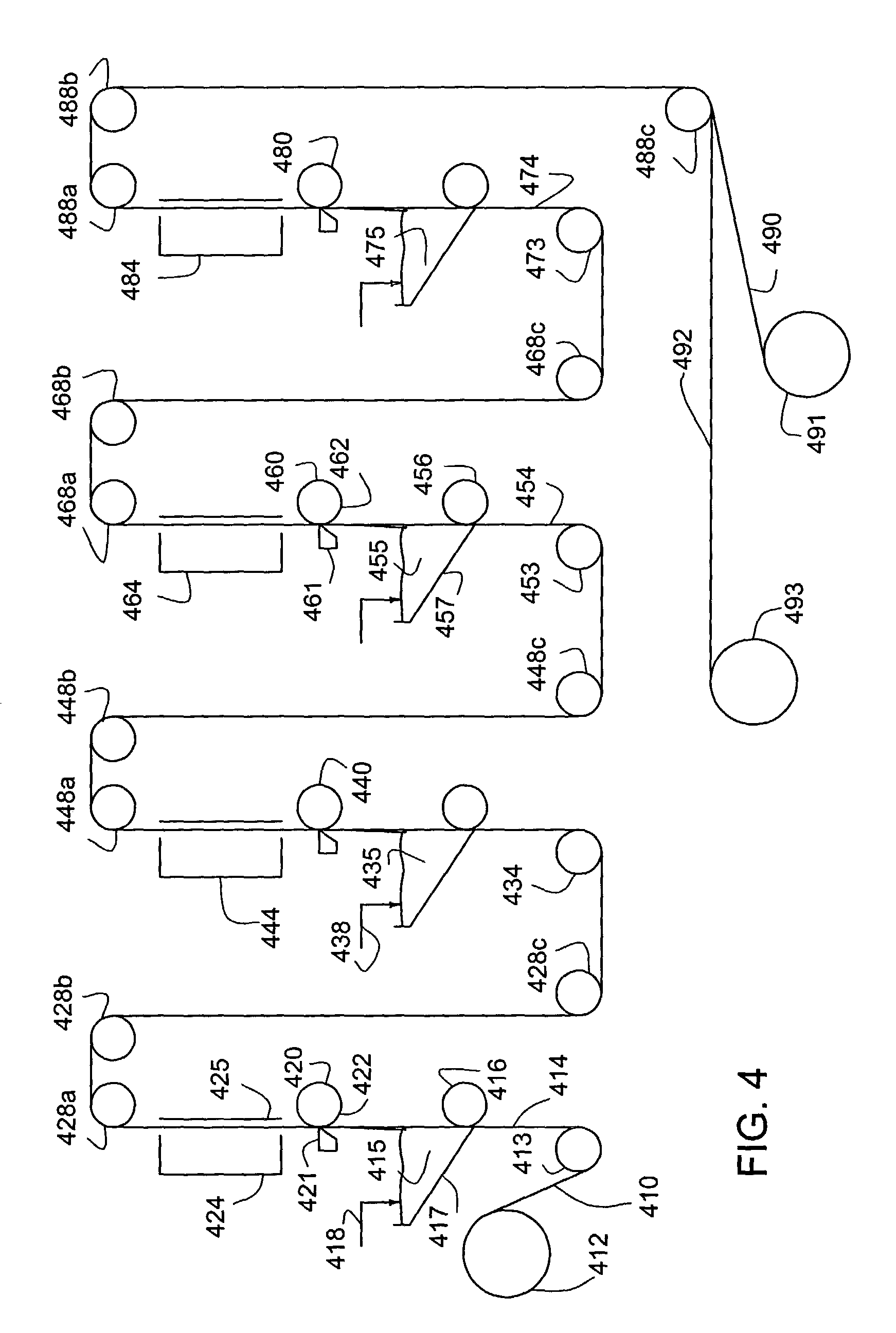Multilayer composite and method of making same
a composite material and multi-layer technology, applied in the field of composite materials, can solve the problems of composites of fluoropolymers and nonfluoropolymers to exhibit low interfacial peel strength, a tendency to delaminate, and low peel strength of composites of fluoropolymers and nonfluoropolymers, and the film of less thickness is usually too weak to be self-supporting or to withstand normal manipulation experienced
- Summary
- Abstract
- Description
- Claims
- Application Information
AI Technical Summary
Benefits of technology
Problems solved by technology
Method used
Image
Examples
example 1
[0080]A multilayer composite was produced using a single stage coating tower assembly similar to that illustrated in FIG. 6. A carrier web of Kapton® polyimide film from DuPont of 0.13 μm (0.005 inch) thick and 0.55 m (22 inches) wide was continuously drawn from a supply roll and passed at 4.9 m / min. (16 ft. / min.) under a 5.1 cm (2 inch) diameter idler roll. The idler roll was submerged in a bath containing Fluon® AD1LN PTFE aqueous dispersion to which 0.5% Zonyl® FSO fluorosurfactant from DuPont had been added to modify the surface tension. The modified aqueous dispersion was diluted with deionized water to achieve a specific gravity of 1.38.
[0081]The carrier web was directed upward and thus emerged from the bath coated on both sides with the dispersion. Above the surface of the bath the dispersion-coated web passed between a pair of stationary Mayer-type metering rods of 12.7 mm (0.5 inch) diameter which were wound with 0.64 mm (0.025 inch) diameter wire. The rods were oriented pa...
examples 2-5
[0087]Composites were manufactured similarly to the procedure of Example 1 as described more fully below. Selected conditions for making each sample and product physical properties are shown in Table I.
[0088]In Example 2, the procedure of Ex. 1 was followed except that the reinforcement fabric was Ahlstrom product 3257 (Ahlstrom Filtration Specialties, Mt. Holly Springs, Pa.) and the gap between the rods for metering the LSR pick up was 0.2 mm (0.008 inch) which caused a pick up of 0.038 mm of LSR. Due to the relative thicknesses of the LSR and the reinforcement, the latter was fully embedded within the second polymeric layer, (i.e., both inboard and outboard faces of the fabric were impregnated with LSR). After removal from the carrier web, the exposed face of the protective layer was smooth and glossy, and the exposed face of the second polymeric layer was slightly textured due to the presence of the reinforcement just beneath the surface.
[0089]In Example 3, the procedure of Ex. 2...
examples 6-10
[0093]A number of multilayer composites were manufactured according to this invention in a fashion similar to the procedure of the preceding examples in which different LSR compositions were utilized. Selected process conditions and product physical properties are shown in Table II. Table III describes the LSR compositions used in the examples.
[0094]In Example 6 the procedure of example 2 was repeated except that the reinforcement material was a plain weave fabric of style 89 glass fiber and the liquid silicone rubber (LSR) composition was (II) (see Table III). The reinforcement was fully embedded within the translucent LSR second polymeric layer.
[0095]Example 7 was produced identically to Ex. 6 except that the LSR composition (IV) was used. The resulting LSR second polymeric layer was fire resistant due to a fire retardant agent included in the LSR composition by the supplier.
[0096]Example 8 was the same as Ex. 7 except that the reinforcement layer was a polyester plain weave fabri...
PUM
| Property | Measurement | Unit |
|---|---|---|
| thickness | aaaaa | aaaaa |
| gloss | aaaaa | aaaaa |
| thickness | aaaaa | aaaaa |
Abstract
Description
Claims
Application Information
 Login to View More
Login to View More - R&D
- Intellectual Property
- Life Sciences
- Materials
- Tech Scout
- Unparalleled Data Quality
- Higher Quality Content
- 60% Fewer Hallucinations
Browse by: Latest US Patents, China's latest patents, Technical Efficacy Thesaurus, Application Domain, Technology Topic, Popular Technical Reports.
© 2025 PatSnap. All rights reserved.Legal|Privacy policy|Modern Slavery Act Transparency Statement|Sitemap|About US| Contact US: help@patsnap.com



